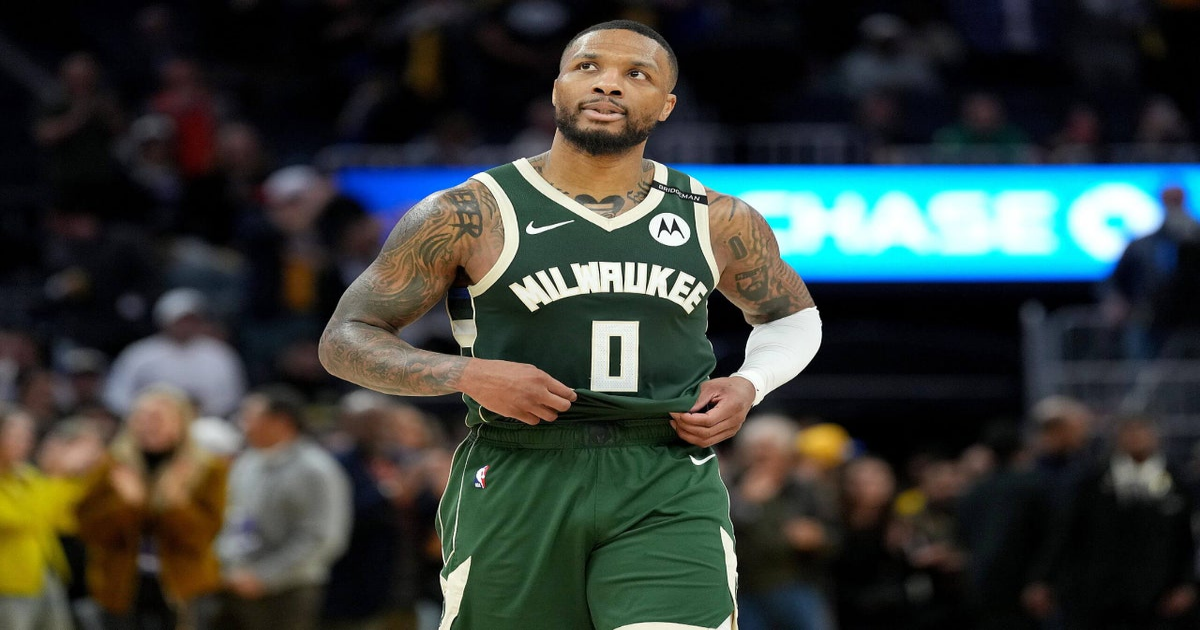MILWAUKEE — In his first media availability since being diagnosed with a deep vein thrombosis (DVT) blood clot in his right calf, Milwaukee Bucks guard Damian Lillard admitted the diagnosis was frightening.
Lillard, who was diagnosed with a blood clot on March 25, missed the final 14 games of the regular season after being put on a blood-thinner medication and testing regularly.
“It was a little bit scary,” Lillard said on Friday. “I think I’ve had a couple of surgeries in my career. I’ve had things I’ve had to deal with, you know, with an ankle or a knee, Achilles, calf, whatever it might be. But those are all things that you go to rehab, you deal with it like that, like an athlete would.
“I’m thinking that’s what I was going into, and then you see a blood clot. Obviously, that’s a thing that can affect your life.”
Aside from what the blood clot meant for his playing status, Lillard was more worried about what it meant off the court. He acknowledged that his cousin dealt with the same issue in 2021, quickly realizing the severity of his diagnosis.
“Honestly, when I say I was scared, I was really nervous about it, based off of a past experience,” Lillard said, “So I wasn’t really thinking about, ‘Oh, I need to get back out there for the playoffs.’ I was just like each time I went back to the hospital, I wanted to hear that it’s gone or it’s smaller or it’s in the same spot, so that was more of my focus.”
The nine-time All-Star first recognized the pain in his calf as similar to a strain, but the swelling and tightness in his leg were alarming enough to get it checked out.
“I was at dinner, and my leg just felt swollen. It was like super tight,” Lillard said. “And that was kind of what led me to go to the team in the first place, because I was just like ‘This ain’t normal.’ We went from there.”
Lillard continued to see specialists who often gave him exercises, like on the bike or in the pool, to help him keep his stamina up, but he felt “normal” four or five days after the blood clot diagnosis.
“I felt like I could physically do anything I could do before, but the fact was, I still had a blood clot in my leg,” said Lillard. “Just being patient and not being in pain, but also knowing that there was still a problem there was one of the hardest things.”
Lillard’s speedy recovery and clearance of a blood clot is unusual and one of the quickest returns the league has ever seen from a deep vein thrombosis issue.
Lillard and the organization shared a great deal of optimism that the point guard would be able to return this season when he was first diagnosed because of how quickly they detected and diagnosed the blood clot, coupled with the early encouraging signs of the treatment’s effectiveness. But it hasn’t been that way for all athletes dealing with this specific blood clot injury. Victor Wembanyama was ruled out for the remainder of the season by the San Antonio Spurs when DVT was discovered in his right shoulder in February.
Ausar Thompson, the Detroit Pistons’ high-flying 22-year-old wing, was diagnosed with a blood clot in March 2024 and did not return to the court until November. Chris Bosh, who played with the Toronto Raptors and Miami Heat and retired in 2019, had a pulmonary embolism before eventually being diagnosed with DVT.
But Lillard’s situation was unique. He’s a 34-year-old who had played in 58 regular-season games before the blood clot issue and averaged 24.9 points (15th in NBA) and 7.1 assists (13th in NBA) per game this season.
Lillard returned to practice Thursday after being cleared of the blood clot and his blood-thinning medication. Although Lillard remains out for Game 1 of the Bucks’ first-round playoff series against the Indiana Pacers beginning Saturday, and his status for Game 2 is unclear, Lillard seems optimistic about returning during the series.
Since being cleared to return to practice, Lillard has been ramping up his workouts with conditioning. The former Weber State guard didn’t want to give a target game or timeline for his return, but said that when he feels confident enough to return to the floor, he will.
“The moment that I feel good about it. I’m not going to be waiting and all of that,” Lillard said. “The moment that I feel I can go, I’m gonna go. So I mean, that’s what I can tell you.”
(Photo: Thearon W. Henderson / Getty Images)



